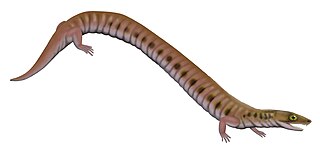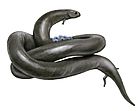
Lepospondyli is a diverse taxon of early tetrapods. With the exception of one late-surviving lepospondyl from the Late Permian of Morocco, lepospondyls lived from the Early Carboniferous (Mississippian) to the Early Permian and were geographically restricted to what is now Europe and North America. Five major groups of lepospondyls are known: Adelospondyli; Aïstopoda; Lysorophia; Microsauria; and Nectridea. Lepospondyls have a diverse range of body forms and include species with newt-like, eel- or snake-like, and lizard-like forms. Various species were aquatic, semiaquatic, or terrestrial. None were large, and they are assumed to have lived in specialized ecological niches not taken by the more numerous temnospondyl amphibians that coexisted with them in the Paleozoic. Lepospondyli was named in 1888 by Karl Alfred von Zittel, who coined the name to include some tetrapods from the Paleozoic that shared some specific characteristics in the notochord and teeth. Lepospondyls have sometimes been considered to be either related or ancestral to modern amphibians or to Amniota. It has been suggested that the grouping is polyphyletic, with aïstopods being primitive stem-tetrapods, while recumbirostran microsaurs are primitive reptiles.

Microsauria is an extinct, possibly polyphyletic order of amphibians from the late Carboniferous and early Permian periods. It is the most diverse and species-rich group of lepospondyls. Recently, Microsauria has been considered paraphyletic, as several other non-microsaur lepospondyl groups such as Lysorophia seem to be nested in it. Microsauria is now commonly used as a collective term for the grade of lepospondyls that were originally classified as members of Microsauria.

Asaphestera is an extinct genus of a tetrapod described on the basis of fossils from the Carboniferous of the Joggins locality in Nova Scotia, Canada. It was originally described as an undetermined lepospondyl and subsequently classified as a microsaur within the family Tuditanidae. A study published in May 2020 found that specimens referred to Asaphestera represented several unrelated species. Steen (1934)'s original species name Asaphestera platyris was retained for a skull which has been re-evaluated as the earliest known synapsid.

Boii is an extinct genus of microsaur within the family Tuditanidae. It was found in Carboniferous coal from mines near the community of Kounov in the Czech Republic. The only remains of the genus consist of a crushed skull, shoulder girdle bones, and scales, which were similar to microsaurian elements originally referred to Asaphestera. Boii can be characterized by its heavily sculptured skull, thin ventral plate of the clavicles, and a larger number of fangs on the roof of the mouth. For many years the type and only known species, Boii crassidens, was considered to be a species of Sparodus, until 1966 when Robert Carroll assigned it to its own genus.

Batropetes is an extinct genus of brachystelechid recumbirostran "microsaur". Batropetes lived during the Sakmarian stage of the Early Permian. Fossils attributable to the type species B. fritschi have been collected from the town of Freital in Saxony, Germany, near the city of Dresden. Additional material has been found from the Saar-Nahe Basin in southwestern Germany and has been assigned to three additional species: B. niederkirchensis, B. palatinus, and B. appelensis.

Carrolla is an extinct genus of brachystelechid 'microsaur' that lived in the Lower Permian in North America. It was named in 1986 by American paleontologists Wann Langston and Everett Olson. The type species, Carrolla craddocki, is the only known species.
Elfridia is a poorly known extinct genus of microsaur within the family Gymnarthridae.

Odonterpeton is an extinct genus of "microsaur" from the Late Carboniferous of Ohio, containing the lone species Odonterpeton triangulare. It is known from a single partial skeleton preserving the skull, forelimbs, and the front part of the torso. The specimen was found in the abandoned Diamond Coal Mine of Linton, Ohio, a fossiliferous coal deposit dated to the late Moscovian stage, about 310 million years ago.
Ricnodon is an extinct genus of microsaur within the family Hapsidopareiidae. The genus name means ‘wrinkled tooth’ from Ancient Greek ῥικνός and odôn. The specific name honors Edward Drinker Cope.

Rhynchonkos is an extinct genus of rhynchonkid microsaur. Originally known as Goniorhynchus, it was renamed in 1981 because the name had already been given to another genus; the family, likewise, was originally named Goniorhynchidae but renamed in 1988. The type and only known species is R. stovalli, found from the Early Permian Fairmont Shale in Cleveland County, Oklahoma. Rhynchonkos shares many similarities with Eocaecilia, an early caecilian from the Early Jurassic of Arizona. Similarities between Rhynchonkos and Eocaecilia have been taken as evidence that caecilians are descendants of microsaurs. However, such a relationship is no longer widely accepted.

Quasicaecilia is an extinct genus of microsaur. It is known from the Early Permian of Texas in the United States. A single specimen is known, collected from the Texas Permian redbeds by Charles Hazelius Sternberg in 1917. It was originally identified as a specimen of the gymnarthrid microsaur Cardiocephalus. The skull is small, less than 2 centimetres (0.79 in) in length, and the otic capsule is very large in comparison to the rest of the skull. The skull of Quasicaecilia superficially resembles those of extant but unrelated caecilians, hence the genus name. Quasicaecilia was assigned to the new family Brachystelechidae in 1991 along with the genera Batropetes and Carrolla.
Trihecaton is an extinct genus of microsaur from the Late Pennsylvanian of Colorado. Known from a single species, Trihecaton howardinus, this genus is distinctive compared to other microsaurs due to possessing a number of plesiomorphic ("primitive") features relative to the rest of the group. These include large intercentra, folded enamel, and a large coronoid process of the jaw. Its classification is controversial due to combining a long body with strong limbs, features which typically are not present at the same time in other microsaurs. Due to its distinctiveness, Trihecaton has been given its own monospecific family, Trihecatontidae.
Utaherpeton is an extinct genus of lepospondyl amphibian from the Carboniferous of Utah. It is one of the oldest and possibly one of the most basal ("primitive") known lepospondyls. The genus is monotypic, including only the type species Utaherpeton franklini. Utaherpeton was named in 1991 from the Manning Canyon Shale Formation, which dates to the Mississippian-Pennsylvanian boundary. It was originally classified within Microsauria, a group of superficially lizard- and salamander-like lepospondyls that is now no longer considered to be a valid clade or evolutionary grouping, but rather an evolutionary grade consisting of the most basal lepospondyls. Utaherpeton has been proposed as both the most basal lepospondyl and the oldest "microsaur", although more derived lepospondyls are known from earlier in the Carboniferous. However, its position within Lepospondyli remains uncertain due to the incomplete preservation of the only known specimen. The inclusion of Utaherpeton in various phylogenetic analyses has resulted in multiple phylogenies that are very different from one another, making it a significant taxon in terms of understanding the interrelationships of lepospondyls.

Brachystelechidae is an extinct family of Early Permian microsaurs. The family was first named by Robert L. Carroll and Pamela Gaskill in 1978, with the only member being Brachystelechus fritschi. Brachystelechus fritschi has since been reassigned to the genus Batropetes. Genera assigned to the family include: Batropetes, from Germany; Carrolla, from Texas; Quasicaecilia, also from Texas; Diabloroter, from the Mazon Creek lagerstätte of Illinois; and Bromerpeton from the Tambach Formation of Germany.
Kirktonecta is an extinct genus of microsaur known from the Carboniferous of West Lothian, Scotland.
Altenglanerpeton is an extinct genus of microsaur tetrapod from the Late Carboniferous or Early Permian of Germany. Altenglanerpeton was named in 2012 after the Altenglan Formation in which it was found. The type and only species is A. schroederi.

Recumbirostra is a clade of tetrapods which lived during the Carboniferous and Permian periods. They are thought to have had a fossorial (burrowing) lifestyle and the group includes both short-bodied and long-bodied snake-like forms. At least one species, the long-bodied molgophid Nagini mazonense, lost its forelimbs entirely. Recumbirostra includes the families Pantylidae, Gymnarthridae, Ostodolepidae, Rhynchonkidae and Brachystelechidae, with additional families such as Microbrachidae and Molgophidae being included by some authors. Brachystelechidae and Molgophidae have also been grouped together in the suggested clade Chthonosauria.
Proxilodon is an extinct genus of recumbirostran microsaur from the Early Permian Speiser Formation of Kansas, United States. It contains a single species, Proxilodon bonneri,.

Andersonerpeton is an extinct genus of aïstopod from the Bashkirian of Nova Scotia, Canada. It is known from a single jaw, which shares an unusual combination of features from both other aistopods and from stem-tetrapod tetrapodomorph fish. As a result, Andersonerpeton is significant for supporting a new classification scheme which states that aistopods evolved much earlier than previously expected. The genus contains a single species, A. longidentatum, which was previously believed to have been a species of the microsaur Hylerpeton.
Diabloroter is a Carboniferous genus of brachystelechid 'microsaur' from the Mazon Creek lagerstätte in Illinois. It was named in 2019 by Arjan Mann and Hillary C. Maddin.












